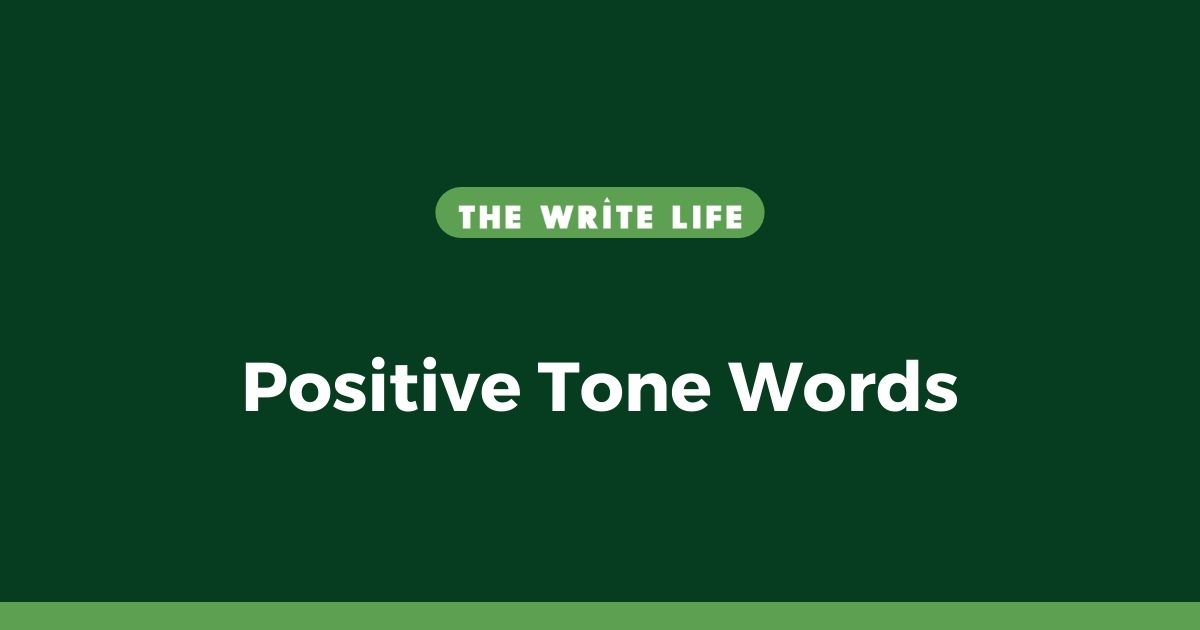No matter what you’re writing, the tone you choose can enhance your message, allowing your readers to experience the emotion behind your words as well as their surface meaning.
This article delves into the power of positive tone words, a key technique for helping your readers experience the positive emotional intention of your writing.
Whether you’re crafting a novel, an email, or a marketing copy, understanding and using positive tone words can make your writing much more effective.
Let’s explore how these tone words can increase the emotional impact your writing has on readers.
The power of positive tone words
Positive tone words are a type of language that enhance the emotional power of your writing.
When you want your content to connect on an emotional as well as intellectual level, tone words are a tried and tested technique.
You can explore the concept of tone words in general in our dedicated guide, but our focus here will be solely on words that engender a positive response.
Let’s start with a basic definition
What are positive tone words?
Positive tone words are expressions that carry a positive connotation, aiming to evoke optimistic, encouraging, and uplifting responses from the reader.
They allow your writing to be effective on two levels – intellectual and emotional.
When used effectively, they cause your reader to not only understand your ideas, but have an emotional response to them at the same time.
Let’s explore how that works on a psychological level.
The psychological impact of positive tone words
Understanding the psychological impact of positive tone words is crucial in harnessing their full potential.
These words can:
- Boost Engagement: Captivate and maintain the reader’s attention more effectively.
- Enhance Persuasiveness: Make arguments and proposals more convincing.
- Evoke Positive Emotions: Stimulate feelings of happiness, optimism, and comfort.
- Increase Comprehension: Make complex information more understandable and relatable.
- Strengthen Connection: Build a deeper emotional bond with the reader.
- Foster Trust and Credibility: Encourage trust in the author’s expertise and intentions.
- Motivate Action: Inspire readers to take desired actions or adopt new perspectives.
Now that you know the impact of positive tone words, let’s delve deeper into how they’re used by skilled writers.
What is the transformative role of positive tone words?
When you decide to leverage the power of positive tone words in your writing, you make a choice to transform the impact it has on readers.
Intentional use of these words shapes your writing’s ambiance, steers its emotional undertones, and ultimately, determines the reader’s engagement level and response to any call to action you include.
Incorporating positive tone words is not just about adding a layer of positivity – it’s about crafting an experience that resonates, persuades, and remains memorable long after your reader has finished your work.
Categories of positive tone words
To achieve a true mastery of positive tone words, recognizing their diversity is key.
Each category serves a unique purpose, enriching your text by evoking specific responses from readers.
From inspiring to respectful, understanding these categories and their nuances can dramatically enhance your writing’s effectiveness and emotional depth.
Let’s explore the main categories of positive tone words and the varying impacts they have.
Inspirational positive tone words
Inspirational tone words are designed to uplift and motivate the reader, pushing them towards personal growth or action.
The intended impact of these words is to spark a sense of possibility and ambition.
Here are seven examples of inspirational positive tone words.
1. Empower: To give someone the strength and confidence to do something.
2. Aspire: To direct one’s hopes towards achieving something.
3. Innovate: To introduce something new or different.
4. Transform: To make a thorough or dramatic change in form, appearance, or character.
5. Overcome: To successfully deal with or gain control of something difficult.
6. Thrive: To grow, develop, or be successful.
7. Illuminate: To light up or make clear.
Affectionate positive tone words
Affectionate tone words convey warmth, care, and love, aiming to create a sense of closeness and comfort.
These words are meant to nurture a feeling of connection and empathy between the writer and the reader.
Here are seven examples.
1. Cherish: To protect and care for someone lovingly.
2. Adore: To love and respect someone deeply.
3. Fondness: A gentle feeling of liking or affection.
4. Warmth: A quality of being friendly, enthusiastic, and affectionate.
5. Nurture: To care for and encourage the growth or development of.
6. Treasure: To hold something dear or valuable.
7. Embrace: To accept or support willingly and enthusiastically.
Grateful positive tone words
Grateful tone words express appreciation and thankfulness, enhancing the reader’s sense of value and acknowledgment.
By using grateful tone words, writers aim to cultivate an atmosphere of mutual respect and appreciation.
1. Appreciate: To recognize the full worth of.
2. Thankful: Expressing gratitude and relief.
3. Valued: To be held in high regard; considered important or beneficial.
4. Honored: To feel respected or esteemed.
5. Blessed: To feel fortunate or lucky.
6. Esteemed: Held in great respect; admired.
7. Recognized: To be acknowledged or regarded as important.
Optimistic positive tone words
Optimistic tone words reflect hope and positive expectations, encouraging a forward-looking perspective.
The goal of these words is to inspire confidence in the future, dispelling doubt and fear.
1. Hopeful: Feeling or inspiring optimism about a future event.
2. Bright: Suggesting a promising future or outcome.
3. Positive: Constructive, optimistic, or confident.
4. Upbeat: Cheerfully optimistic and positive.
5. Promising: Showing signs of future success or excellence.
6. Sanguine: Optimistic or positive, especially in an apparently bad or difficult situation.
7. Confident: Feeling or showing certainty about something.
Encouraging positive tone words
Encouraging tone words offer support and confidence, bolstering the reader’s courage and resolve.
These words aim to empower the reader, fostering a sense of belief in their abilities and potential.
1. Support: To bear all or part of the weight; to hold up.
2. Motivate: To provide someone with a reason for doing something.
3. Boost: To help or encourage to increase or improve.
4. Inspire: To fill with the urge or ability to do or feel something.
5. Uplift: To elevate or stimulate (someone) morally or spiritually.
6. Reassure: To remove someone’s doubts or fears.
7. Energize: To give vitality and enthusiasm to.
Respectful positive tone words
Respectful tone words show esteem and regard for others, reinforcing the writer’s respect for the reader’s opinions and feelings.
Utilizing respectful tone words is about acknowledging the dignity and worth of the topic and the reader’s perspective.
1. Esteem: To regard highly or favorably; admire.
2. Honor: To hold in high respect; to revere.
3. Appreciate: To recognize the full worth of.
4. Regard: Consideration or thoughtfulness in relation to someone.
5. Dignify: To confer honor or dignity upon; to elevate.
6. Revere: To feel deep respect or admiration for something.
7. Value: To consider with respect to worth, excellence, usefulness, or importance.
Hopefully you now see that even though positive tone words are a category of the broader tone words concept, they can be further categorized depending on the precise impact you intend for your writing.
How to use positive tone words effectively

Mastering the use of positive tone words is not about expanding your vocabulary. Instead, it’s about intentional word placement and understanding the dynamics of communication.
We’ll now take a look at key considerations for effectively integrating positive tone words into your writing, ensuring they enhance rather than detract from your message.
Why context matters when using tone words
The relevance of positive tone words is deeply tied to the context in which they are used.
Selecting the right word requires an understanding of the situation, the message’s purpose, and the desired outcome.
This intentional choice ensures that the tone words amplify your message’s clarity and emotional resonance, making the communication more impactful and aligned with the your intention as a writer.
Choosing the right positive language for your readers
Knowing your readership is crucial when choosing positive tone words.
Different groups may respond uniquely to the same words based on cultural, social, or personal factors.
Tailoring your language to resonate with your specific readers enhances the connection and effectiveness of your writing, making it more likely to inspire, motivate, or comfort as intended.
Make sure your use of tone words is balanced and authentic
Using positive tone words with balance and authenticity is key to maintaining credibility and trust.
Overuse or inappropriate use can make your writing seem insincere or forced, undermining your message’s authenticity.
Strive for a natural integration of positive tone words that genuinely reflects your voice and intent.
How tone words increase the clarity of your writing
Positive tone words, when used carefully, can significantly enhance the clarity and impact of your writing.
They serve not only to embellish but to clarify your intentions, making your arguments more persuasive and your narratives more engaging.
Ultimately, if using a positive tone word or phrase makes your writing less clear, it’s a sign that you’re using it incorrectly.
Examples of positive tone words in writing
Illustrating the power of positive tone words with examples provides a clear, practical understanding of how they can transform your writing.
We’ll now showcase their effectiveness in various contexts, highlighting the nuanced ways in which they can influence a message.
Examples of sentences with and without positive tone words
While the following five sentences have similar surface level meanings with and without positive tone words, notice the different emotional feel they have.
- Without: “You did not fail.”
With: “You showed resilience in facing challenges.” - Without: “This is acceptable.”
With: “This work is commendable.” - Without: “Your effort is noticed.”
With: “Your dedication is truly appreciated.” - Without: “This situation is not bad.”
With: “This situation holds promising opportunities.” - Without: “You might be right.”
With: “You bring a valuable perspective.”
Now that we’ve looked at some basic, easily-understandable examples, let’s analyze a little deeper.
What is the change in impact of adding. a positive tone word to a sentence?
Revising sentences to incorporate positive tone words transforms the message from neutral or minimally positive to distinctly encouraging and appreciative.
This shift not only elevates the vibe of the communication but also strengthens the connection between the writer and the reader.
By affirming the positive aspects, the revisions foster a more engaged, motivated, and valued feeling, enhancing the overall mood of the message.
How positive tone words are used in different forms of writing
Incorporating positive tone words is effective across writing of any format or genre.
Let’s take a look at their impact when used in different contexts.
1. Fiction: Brings characters and emotions to life, making the narrative more compelling.
2. Non-fiction: Enhances the persuasiveness and readability of factual and informative content.
3. Business Communication: Builds rapport and positive relationships with clients and colleagues.
4. Emails: Conveys warmth and professionalism, encouraging positive responses.
5. Marketing Copy: Engages and persuades the audience, increasing the impact of the message.
This wide range application proves the versatility and power of positive tone words, making them indispensable tools for writers of any discipline.
Mistakes to avoid when using positive tone words
While positive tone words can enhance your writing, you need to avoid particular pitfalls that detract from their effectiveness.
Let’s explore some common mistakes to avoid to maintain their authenticity and impact.
1 – Don’t overuse positive tone words
Excessive reliance on positive tone words can lead to writing that feels forced or insincere.
Striking the right balance is crucial; your words should feel natural and fitting to the context.
Overuse can dilute your writing’s power, leaving readers skeptical of the genuineness of your sentiment and potentially undermining the credibility of your message.
2 – Avoid unsuitable situations
Not every situation benefits from an overly positive spin.
Misusing positive tone words, especially in negative or serious contexts, can seem dismissive or inappropriate.
It’s important to match the tone with the message’s nature and the readers’ expectations to ensure that your writing is received as intended and maintains its respectfulness and sensitivity.
3 – Write with your readers in mind
Ignoring the people you’re writing for, and the receptivity of your readers to particular types of positive tone words can lead to miscommunication and disengagement.
Tailoring your tone to suit the situation and your readers’ preferences, expectations, and cultural context is key to effective writing.
Understanding and respecting these aspects ensure that your message is both appropriate and impactful.
How to improve your use of positive tone words with practice exercises
Practicing the use of positive tone words is essential for mastering their effective integration into your writing.
We’re excited to share some exercises designed to refine your skills, and prompts to stimulate your creative use of positive language.
Positive tone words writing exercises
While knowledge is essential in becoming a better writing, nothing beats hands-on practice.
Here are five exercises allowing you to gain firsthand familiarity with positive tone words and their use.
1. Rewrite a Paragraph: Choose a neutral or negatively toned paragraph and rewrite it using positive tone words.
2. Daily Writing Prompt: Incorporate a specific positive tone word into a short piece of writing each day.
3. Tone Transformation: Take a piece of your own writing and transform its tone to be more positive without altering the core message.
4. Audience Adaptation: Write a message intended for two different audiences, using positive tone words tailored to each.
5. Contextual Application: Create two responses to a scenario: one using positive tone words inappropriately, and one using them effectively.
Writing prompts focused on positive tone words
These scenarios and writing prompts are designed to grow your skill and confidence in using positive tone words.
- A letter of appreciation to someone who has impacted your life.
- An email response to a customer’s complaint.
- A motivational speech for a team facing challenges.
- A reflection on a personal achievement or milestone.
- A product description for a new launch.
- A review of a book or movie with a positive impact.
- An opinion piece on a community issue with a hopeful outlook.
- A persuasive article advocating for a cause you care about.
- A dialogue between characters with differing viewpoints, aiming for resolution.
- An introduction to a proposal or project that seeks buy-in.
- A journal entry focusing on gratitude and positive experiences.
Are you ready to put your knowledge of tone words to the test?
This guide has equipped you with the understanding, examples, and exercises needed to integrate positive tone words into your writing skillfully.
Now it’s up to you to put your knowledge to good use!
Dive into the practice exercises, experiment with the scenarios, and observe the profound impact positive tone words can have on your writing and your readers.










